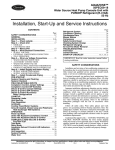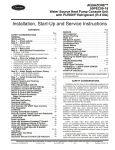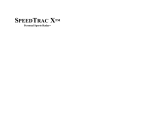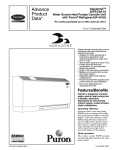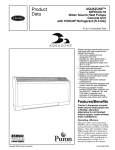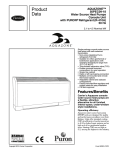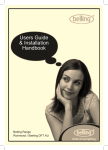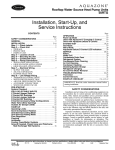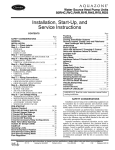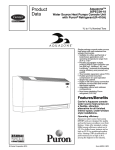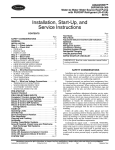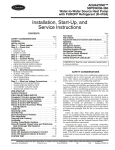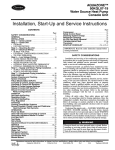Download Carrier AQUAZONE 50PEC09-18 Programming instructions
Transcript
Aquazone™ 50PEC09-18 Water Source Heat Pumps Console Unit with Puron® Refrigerant (R-410A) Installation, Start-Up and Service Instructions CONTENTS Page SAFETY CONSIDERATIONS . . . . . . . . . . . . . . . . . . . . .1,2 GENERAL . . . . . . . . . . . . . . . . . . . . . . . . . . . . . . . . . . . . . . . . 2 INSTALLATION . . . . . . . . . . . . . . . . . . . . . . . . . . . . . . . . 2-10 Step 1 — Check Jobsite . . . . . . . . . . . . . . . . . . . . . . . . . . 2 Step 2 — Check Unit . . . . . . . . . . . . . . . . . . . . . . . . . . . . . 2 • STORAGE • UNIT PROTECTION Step 3 — Mount Unit . . . . . . . . . . . . . . . . . . . . . . . . . . . . . 5 Step 4 — Wire Electrical Connections . . . . . . . . . . . . 5 • SUPPLY VOLTAGE • EXTERNAL LOOP POWER CONNECTION • 230-V OPERATION Step 5 — Install Supply and Return Piping . . . . . . . 9 • SUPPLY AND RETURN HOSES • SUPPLY AND RETURN PIPING Step 6 — Install Condensate Piping . . . . . . . . . . . . . . 9 PRE-START-UP . . . . . . . . . . . . . . . . . . . . . . . . . . . . . . . .10,11 System Cleaning and Flushing . . . . . . . . . . . . . . . . . . 10 System Checkout . . . . . . . . . . . . . . . . . . . . . . . . . . . . . . . 10 FIELD SELECTABLE INPUTS. . . . . . . . . . . . . . . . . . . . 12 START-UP . . . . . . . . . . . . . . . . . . . . . . . . . . . . . . . . . . . . 12-14 Unit Start-Up/Cooling . . . . . . . . . . . . . . . . . . . . . . . . . . . 12 Operating Limits . . . . . . . . . . . . . . . . . . . . . . . . . . . . . . . . 12 Unit Start-Up/Heating . . . . . . . . . . . . . . . . . . . . . . . . . . . 12 Flow Regulation. . . . . . . . . . . . . . . . . . . . . . . . . . . . . . . . . 12 Antifreeze . . . . . . . . . . . . . . . . . . . . . . . . . . . . . . . . . . . . . . . 12 Cooling Tower/Boiler Systems . . . . . . . . . . . . . . . . . . 14 Ground Coupled, Closed Loop and Plateframe Heat Exchanger Well Systems . . . . . . . . . . . . . . . . 14 OPERATION . . . . . . . . . . . . . . . . . . . . . . . . . . . . . . . . . . . . . 14 Power Up Mode . . . . . . . . . . . . . . . . . . . . . . . . . . . . . . . . . 14 Programming Instructions . . . . . . . . . . . . . . . . . . . . . . 14 Units with Aquazone Complete C Control . . . . . . . 14 Units with Aquazone Deluxe D Control . . . . . . . . . . 14 COMPLETE C AND DELUXE D BOARD SYSTEM TEST . . . . . . . . . . . . . . . . . . . . . . . . . . . . . .14,15 Retry Mode. . . . . . . . . . . . . . . . . . . . . . . . . . . . . . . . . . . . . . 14 LED Fault Indication. . . . . . . . . . . . . . . . . . . . . . . . . . . . . 15 Complete C Board Default Settings . . . . . . . . . . . . . . 15 SERVICE . . . . . . . . . . . . . . . . . . . . . . . . . . . . . . . . . . . . . 15-17 Unit Inspection . . . . . . . . . . . . . . . . . . . . . . . . . . . . . . . . . . 15 System Flushing . . . . . . . . . . . . . . . . . . . . . . . . . . . . . . . . 15 Water Coil . . . . . . . . . . . . . . . . . . . . . . . . . . . . . . . . . . . . . . . 16 Refrigerant System . . . . . . . . . . . . . . . . . . . . . . . . . . . 16 Condenser Cleaning . . . . . . . . . . . . . . . . . . . . . . . . . . . . 16 Condensate Pans . . . . . . . . . . . . . . . . . . . . . . . . . . . . . . . 16 Blower Motors . . . . . . . . . . . . . . . . . . . . . . . . . . . . . . . . . . 16 Compressor. . . . . . . . . . . . . . . . . . . . . . . . . . . . . . . . . . . . . 16 Safety Control Reset . . . . . . . . . . . . . . . . . . . . . . . . . . . . 16 Checking System Charge . . . . . . . . . . . . . . . . . . . . . . . 16 Page Refrigerant Charging. . . . . . . . . . . . . . . . . . . . . . . . . . . . 17 Air Coil Fan Motor Removal . . . . . . . . . . . . . . . . . . . . . 17 TROUBLESHOOTING . . . . . . . . . . . . . . . . . . . . . . . 17,18 Thermistor . . . . . . . . . . . . . . . . . . . . . . . . . . . . . . . . . . . . . . 17 START-UP CHECKLIST . . . . . . . . . . . . . . . . . . .CL-1, CL-2 IMPORTANT: Read the entire instruction manual before starting installation. SAFETY CONSIDERATIONS Installation and servicing of air-conditioning equipment can be hazardous due to system pressure and electrical components. Only trained and qualified service personnel should install, repair, or service air-conditioning equipment. Untrained personnel can perform basic maintenance functions of cleaning coils and filters and replacing filters. All other operations should be performed by trained service personnel. When working on air-conditioning equipment, observe precautions in the literature, tags and labels attached to the unit, and other safety precautions that may apply. Improper installation, adjustment, alteration, service, maintenance, or use can cause explosion, fire, electrical shock or other conditions which may cause personal injury or property damage. Consult a qualified installer, service agency, or your distributor or branch for information or assistance. The qualified installer or agency must use factory-authorized kits or accessories when modifying this product. Refer to the individual instructions packaged with the kits or accessories when installing. Follow all safety codes. Wear safety glasses and work gloves. Use quenching cloth for brazing operations. Have fire extinguisher available. Read these instructions thoroughly and follow all warnings or cautions attached to the unit. Consult local building codes and applicable electrical codes for special installation requirements. Understand the signal words — DANGER, WARNING, and CAUTION. DANGER identifies the most serious hazards which will result in severe personal injury or death. WARNING signifies hazards that could result in personal injury or death. CAUTION is used to identify unsafe practices, which would result in minor personal injury or product and property damage. WARNING Electrical shock can cause personal injury or death. Before installing or servicing system, always turn off main power to system. There may be more than one disconnect switch. Turn off accessory heater power if applicable. Manufacturer reserves the right to discontinue, or change at any time, specifications or designs without notice and without incurring obligations. Catalog No. 04-53500102-01 Printed in U.S.A. Form 50PEC-3SI Pg 1 8-14 Replaces: NEW 1. Compare the electrical data on the unit nameplate with ordering and shipping information to verify that the correct unit has been shipped. 2. Keep both the chassis and cabinet covered with the shipping carton until all plastering, painting, and finish work is complete and it is time to install the chassis and cabinet. 3. Verify that the refrigerant tubing is free of kinks or dents, and that it does not touch other unit components. 4. Inspect all electrical connections. Connections must be clean and tight at the terminals. WARNING DO NOT USE TORCH to remove any component. System contains oil and refrigerant under pressure. To remove a component, wear protective gloves and goggles and proceed as follows: a. Shut off electrical power to unit. b. Recover refrigerant to relieve all pressure from system using both high-pressure and low pressure ports. c. Traces of vapor should be displaced with nitrogen and the work area should be well ventilated. Refrigerant in contact with an open flame produces toxic gases. d. Cut component connection tubing with tubing cutter and remove component from unit. Use a pan to catch any oil that may come out of the lines and as a gage for how much oil to add to the system. e. Carefully unsweat remaining tubing stubs when necessary. Oil can ignite when exposed to torch flame. Failure to follow these procedures may result in personal injury or death. CAUTION To avoid equipment damage, do not use these units as a source of heating or cooling during the construction process. The mechanical components and filters used in these units quickly become clogged with construction dirt and debris which may cause system damage. CAUTION To avoid the release of refrigerant into the atmosphere, the refrigerant circuit of this unit must only be serviced by technicians who meet local, regional, and national proficiency requirements. CAUTION DO NOT re-use compressor oil or any oil that has been exposed to the atmosphere. Dispose of oil per local codes and regulations. DO NOT leave refrigerant system open to air any longer than the actual time required to service the equipment. Seal circuits being serviced and charge with dry nitrogen to prevent oil contamination when timely repairs cannot be completed. Failure to follow these procedures may result in damage to equipment. CAUTION All refrigerant discharged from this unit must be recovered without exception. Technicians must follow industry accepted guidelines and all local, regional, and national statutes for the recovery and disposal of refrigerants. CAUTION GENERAL When a compressor is removed from this unit, system refrigerant circuit oil will remain in the compressor. To avoid leakage of compressor oil, the refrigerant lines of the compressor must be sealed after it is removed. The 50PEC water source heat pump console unit is a decentralized room terminal designed for field connection to a closed-circuit piping loop. Units are typically installed in perimeter zones, usually under windows. Supply air is discharged directly into the conditioned space through discharge grilles located in the top of the unit. Step 2 — Check Unit — Upon receipt of shipment at the jobsite, carefully check the shipment against the bill of lading. Make sure all units have been received. Inspect the carton or crating of each unit, and inspect each unit for damage. Ensure the shipping company makes proper notation of any shortages or damage on all copies of the freight bill. Concealed damage not discovered during unloading must be reported to the shipping company within 15 days of receipt of shipment. NOTE: It is the responsibility of the purchaser to file all necessary claims with the shipping company. IMPORTANT: The installation of console water source heat pump units and all associated components, parts, and accessories which make up the installation shall be in accordance with the regulations of ALL authorities having jurisdiction and MUST conform to all applicable codes. It is the responsibility of the installing contractor to determine and comply with ALL applicable codes and regulations. STORAGE INSTALLATION CAUTION Step 1 — Check Jobsite — Units are typically in- stalled along an outside wall of the room. Refer to Fig. 1 and 2 for an illustration showing piping locations. Install units with adequate clearance to allow maintenance and servicing. Refer to Table 1. Locate the console unit so that it provides adequate air circulation throughout the room. Installation, operation and maintenance instructions are provided with each unit. Before unit start-up, read all manuals and become familiar with the unit and its operation. Thoroughly check out the system before operation. Complete the inspections and instructions listed below to prepare a unit for installation. DO NOT store or install console units in corrosive environments or in locations subject to temperature or humidity extremes (e.g., attics, garages, rooftops, etc.). Corrosive conditions and high temperature or humidity can significantly reduce performance, reliability, and service life. Always move units in an upright position. Tilting units on their sides may cause equipment damage. Upon the arrival of equipment at the jobsite, immediately store units in their shipping cartons in a clean, dry area. 2 fireproof material has not been completed, all due precautions must be taken to avoid physical damage to the units and contamination by foreign material. Physical damage and contamination may prevent proper start-up and may result in costly equipment clean-up. Examine all pipes, fittings, and valves before installing any of the system components. Remove any dirt found on these components. IMPORTANT: Store units in an upright position at all times. Stack units a maximum of 3 units high. Use pallets to separate each layer of units. DO NOT remove equipment from shipping cartons until equipment is required for installation. UNIT PROTECTION — Cover console units on the jobsite with either shipping cartons, vinyl film, or an equivalent protective covering. Cap the open ends of pipes stored on the jobsite. In areas where painting, plastering, or the spraying of Table 1 — 50PEC Physical Data BASE UNIT 50PEC COMPRESSOR (1 each) Maximum Water Working Pressure (psig/kPa) 09 Rotary 12 Rotary 15 Rotary 18 Rotary 400/3100 400/3100 400/3100 400/3100 PSC/2 PSC/2 PSC/2 PSC/2 1/10 1/10 1/4 1/4 PSC Fan Motor and Blower Fan Motor Type/Speeds Fan Motor (hp) 5.5 x 8.0 (X 2) Blower Wheel Size (Dia x W) (in.) (qty) WATER CONNECTION SIZE (in.) 5.5 x 8.0 (X 2) 5.5 x 8.0 (X 2) 5/8 in. Sweat (Optional 1/2 in. FPT) 0.15 Coaxial Coil Volume (gal) 3/ Condensate Connection in. FPT 4 ID (1 OD) 0.15 3/ 4 ID 5.5 x 8.0 (X 2) 0.31 (1 OD) 3/ 4 ID (1 OD) 0.31 3/ 4 ID (1 OD) VERTICAL CABINET 19 22 23 23 10 x 27 10 x 27 10 x 27 10 x 27 7 x 311/4 x 3/8 7 x 311/4 x 3/8 7 x 311/4 x 3/8 7 x 311/4 x 3/8 Weight - Operating (lb) 131 138 144 144 Weight - Shipping (lb) 151 158 164 164 Refrigeration Charge (oz) Air Coil Dimensions (H x L) Standard Filter - 1/2 in. Washable Aluminum (H x L) LEGEND FPT — Female Pipe Thread PSC — Permanent Split Capacitor RIGHT HAND WATER CONNECTIONS 2.875 LEFT HAND WATER CONNECTIONS 6.00 45.00 45.00 6.00 6.125 23.875 12.875 30.75 3.375 48.00 48.00 15.875 30.75 11.00 12.00 NOTES: 1. All dimensions within ± 0.125 inches. 2. Specifications subject to change without notice. Fig. 1 — 50PEC09-18 Unit Console Dimensions 3 LEFT HAND WATER 42.75 11.00 8.00 1.38 12.00 0.75 Water Out 1.00 2.75 2.00 Water In 19.56 Condensate Water 15.63 13.75 13.50 5.00 1.75 3.38 1.63 RIGHT HAND WATER Disconnect Switch 0.75 42.75 11.00 4.88 8.00 2.75 Disconnect Switch 0.75 2.00 Water In 15.63 1.00 Water Out 15.00 13.75 8.69 Condensate Water 4.00 7.31 NOTES: 1. All dimensions are within ± 0.125 inch. 2. Console units must be installed with a cabinet and subbase. 3. Unit controller shown, other control options may have a different control panel configuration. 4. Specifications subject to change without notice. Fig. 2 — 50PEC09-18 Unit Chassis Dimensions 4 conform to the Class II temperature limitations described in the NEC. Consult the unit wiring diagram located on the inside of the compressor access panel to ensure proper electrical hookup. The installing (or electrical) contractor must make the field connections shown in Fig. 4 when using field-supplied disconnect. Refer to unit wiring diagrams Fig. 5-7 for a schematic of the field connections, which must be made by the installing (or electrical) contractor. Operating voltage must be within voltage range shown in Table 2. Make all final electrical connections with a length of flexible conduit to minimize vibration and sound transmission to the building. SUPPLY VOLTAGE — Operating voltage to unit must be within voltage range indicated on unit nameplate. EXTERNAL LOOP POWER CONNECTION — If the unit will be connected to an external loop pump or flow controller, connect the pump to the loop pump terminal block PB1. The maximum power handling is 4 amps at 240-v. The pumps will automatically cycle as required by the unit. 230-V OPERATION — All 208/230-v units are factorywired for 208-v. The transformer wiring may be switched for 230-v operation (as illustrated on the wiring diagrams) by switching the RED and ORG leads at L1. Step 3 — Mount Unit 1. Unpack the unit from the shipping carton. Remove the front cabinet by lifting up and away from the backplate. Protect the cabinet from damage during installation by returning it to its original vinyl pack until required. 2. Remove compressor isolation plate shipping bolts, as shown in Fig. 3. 3. Using a carpenter’s square and a level, ensure the unit is level. Shim the unit if necessary to assure proper installation. Poor or inadequate installation may result in noisy unit operation or unattractive appearance. 4. Select the proper fasteners to connect the backplate securely to the wall. 5. Fasten the backplate onto the wall through the screw holes located in the back flange. Secure the subbase in place. Step 4 — Wire Electrical Connections WARNING To avoid possible injury or death due to electrical shock, open the power supply disconnect switch and secure it in an open position during installation. SHIPPING BOLTS CAUTION Use only copper conductors for field-installed electrical wiring. Unit terminals are not designed to accept other types of conductors. All field-installed wiring, including the electrical ground, MUST comply with National Electrical Code (NEC) as well as all applicable local codes. In addition, all field wiring must Fig. 3 — Remove Shipping Bolts on Compressor Isolator Plate A FIELD SUPPLIED DISCONNECT SWITCH WARNING Disconnect electrical power source to prevent injury or death from electrical shock. HEAT PUMP ROOM THERMOSTAT B CAUTION A = Two power wires for single-phase units. Use copper conductors only to prevent equipment damage. B = 1 heat/1 cool/manual or auto changeover remote 24-V thermostat. NOTE: All customer-supplied wiring to be copper only and must conform to national and local electrical codes. Wiring shown with dashed lines must be field-supplied and field-installed. “B” wiring only required with systems using remote-mounted thermostats. Fig. 4 — Typical Field-Installed Wiring 5 6 – ENERGY MANAGEMENT SYSTEM RELAY Fig. 5 — Single Phase/Single Stage Unit Mounted Controller ONCE THE DESIRED FEATURE IS SELECTED, USE THE ARROW BUTTONS TO ADJUST IT. THE CONTROLLER WILL REVERT TO NORMAL OPERATION AFTER 5 SECONDS OF NO ACTIVITY. USE THE (MODE) BUTTON TO SELECT THE FEATURE TO BE CONFIGURED: FARENHEIT/CELSIUS (F/C), TEMPERATURE DIFFERENTIAL, TIME DELAY/NO TIME DELAY (dE/nd), CYCYLING FAN/CONSTANT FAN (CY/CO). PROGRAMMING INSTRUCTIONS: TO PROGRAM THE CONTROLLER’S USER CONFIGURABLE FEATURES PRESS THE TEMPERATURE UP AND DOWN ARROW BUTTONS SIMULTANEOUSLY AND HOLD FOR 5 SECONDS. THIS WILL PUT THE CONTROLLER IN THE CONFIGURATION MODE. EMS 7 LP COMPLETE C – LOOP PUMP COMPLETE C EVOL EMS – ENERGY MANAGEMENT SYSTEM RELAY Fig. 6 — Single Phase/Single Stage Complete C Controller 8 LP DELUXE D – LOOP PUMP DELUXE D Fig. 7 — Single Phase/Single Stage Deluxe D Controller Table 2 — Electrical Data — 50PEC Units 50PEC UNIT SIZE 115-1-60 208/230-1-60 265-1-60 115-1-60 208/230-1-60 265-1-60 115-1-60 208/230-1-60 265-1-60 208/230-1-60 265-1-60 09 12 15 18 FLA HACR LRA RLA VOLTAGE V-PH-Hz — — — — QTY 1 1 1 1 1 1 1 1 1 1 1 COMPRESSOR RLA 7.0 3.4 2.9 9.6 4.6 3.8 12.7 5.6 4.6 7.4 6.0 LRA 45.6 22.2 18.8 58.4 27.9 22.2 63.0 29.0 20.0 33.0 28.0 QTY 1 1 1 1 1 1 1 1 1 1 1 BLOWER FLA 2.1 0.7 1.0 2.1 0.7 1.0 1.3 0.8 0.8 0.8 0.8 HP 0.10 0.10 0.10 0.10 0.10 0.10 0.25 0.25 0.25 0.25 0.25 MIN CIRCUIT MAX FUSE/ AMPS HACR 10.9 5.0 4.6 14.1 6.5 5.8 17.2 7.8 6.6 10.1 8.3 15 15 15 20 15 15 25 15 15 15 15 LEGEND Full Load Amps Heating, Air Conditioning and Refrigeration Locked Rotor Amps Rated Load Amps • Insulation is not normally required on supply and return piping for boiler tower installations except in unheated sections or outdoor runs. • Insulation is required for closed-loop geothermal installations as loop temperatures may fall below the dew point and can even fall below the freezing point of water during heating season. 1. Install a drain valve at the base of each supply and return riser to enable system flushing at start-up and during routine servicing. 2. Install shut-off/balancing valves and unions at each unit to allow unit removal for servicing. NOTE: If flex hoses are used, unions are not necessary. 3. Install strainers at the inlet of each system circulating pump. Step 5 — Install Supply and Return Piping CAUTION To ensure proper functioning of unit and system, be sure to connect entering water to upper pipe on right-hand units. On left-hand units, connect entering water to lower pipe. Failure to do so could result in equipment damage. SUPPLY AND RETURN HOSES — Optional pressure-rated hose assemblies are available for use with units. Use the following guidelines when installing supply and return hose assemblies. 1. Install supply and return hoses fitted with swivel-joint fittings at one end to prevent the hose from twisting. 2. Use male adapters to secure the hose assembly to the unit and the riser. 3. Do not allow the hose to twist during installation. Twisting may damage the hose wall or the rubber compound. 4. Use pipe joint compound sparingly on the fitting adapters’ male pipe threads. 5. Prevent sealant from reaching the joint’s flared surfaces. 6. Do not use pipe joint compound when Teflon* thread tape is pre-applied to hose assemblies or when flared-end connections are used. 7. Maximum torque that may be applied to brass fittings is 30 ft-lb. When a torque wrench is not used, tighten brass fittings finger-tight plus one quarter turn. 8. Tighten steel fittings as necessary. 9. Use shut-off/balancing valves, flow indicators, and drain tees in the supply runout and return at each floor to aid in loop balancing and servicing. SUPPLY AND RETURN PIPING — System piping MUST comply with all applicable codes. The following items should be adhered to in addition to applicable piping codes. • A drain valve at the base of each riser to enable proper flushing of the system at start-up and during servicing. • Shut-off/isolation ball valves at the supply and return connections and unions at each unit to permit proper flow balancing and unit servicing. • Strainers at the inlet of each circulating pump. • Use of Teflon tape on threaded pipe fittings to eliminate water leaks and ensure against air entering the system. • Flexible hose connections between the unit and the rigid system to eliminate the possibility of vibration transmission through the piping. IMPORTANT: Since loop temperatures are normally between 60 and 90 F, pipe sweating and heat loss do not occur at normal ambient temperature conditions. Insulation must be installed on loop water piping on those sections that run through unheated areas or are located outside the building. If loop temperatures are expected below the ambient dew point, the optional internal insulation (extended range) package must be ordered. CAUTION DO NOT bend or kink supply lines or hoses. Damage to unit may result. 4. Before making the final water connections, flush the system as described in the Pre-Start-Up section of this manual. After flushing the system, connect piping and hoses to the proper supply, return and condensate connections of the unit. NOTE: When necessary, use adapters to connect hoses. 5. Install any other system components, as required, following manufacturer’s instructions. 6. Reinstall the front cabinet by carefully lowering the front cabinet over the chassis onto the backplate. Step 6 — Install Condensate Piping — Console units are designed with a blow-through configuration in the air handling section. This means that there is positive pressure at the unit drain pan and thus trapping is not required. Condensate is routed from the drain pan via a 5/8-in. non-pressure rated vinyl hose that is located below the supply and return water connections. * Registered trademark of DuPont. 9 Though horizontal runs of condensate piping are usually too short to pose problems, horizontal runs should be pitched at least 1 inch for every 10 feet of piping. Avoid low spots or unpitched piping, as these areas can collect sediment and eventually block condensate flow. Always inspect both internal and external condensate piping for kinks that could block condensate flow. and return connections on each unit. Refill the system and bleed off all air. 10. Test the system pH with litmus paper. The system water should be slightly alkaline (pH 7.0 to 8.5). Add chemicals, as appropriate, to maintain acidity levels. PRE-START-UP DO NOT use “Stop-Leak” or any similar chemical agent in this system. Addition of these chemicals to the loop water will foul the system and will inhibit unit operation. CAUTION System Cleaning and Flushing — Cleaning and flushing the unit and system is the single most important step to ensure proper start-up and continued efficient operation of the system. See Tables 3 and 4. 11. When the system is successfully cleaned, flushed, refilled and bled, check the main system panels, safety cutouts and alarms. Set the controls to properly maintain loop temperatures. WARNING To prevent injury or death due to electrical shock or contact with moving parts, open unit disconnect before servicing unit. System Checkout — After completing the installation, and before energizing the unit, the following system checks should be made: 1. Verify that the supply voltage to the heat pump is in accordance with the nameplate ratings. 2. Make sure that all electrical connections are tight and secure. 3. Check the electrical fusing and wiring for the correct size. 4. Verify that the low voltage wiring between the thermostat and the unit is correct. 5. Verify that the water piping is complete and correct. 6. Check that the water flow is correct, and adjust if necessary. See Table 3. 7. Check the blower for free rotation, and that it is secured to the shaft. 8. Verify that vibration isolation has been provided. 9. Unit is serviceable. Be certain that all access panels are secured in place. Follow the instructions below to properly clean and flush the system: CAUTION DO NOT FLUSH SYSTEM THROUGH THE UNIT! 1. Verify that electrical power to the units is disconnected, and that the circulation pump is deenergized. 2. Connect the supply hose directly to the return riser valve. Use a single length of flexible hose. NOTE: If the length of hose is too short (i.e., the resulting connection would exceed the minimum bend radius of the hose), substitute two lengths of flexible hose joined together with a field-supplied, standard NPT coupling and the flare-fitting-topipe adapters provided with the hose kit. 3. Open all air vents. Fill the system with water. Do not allow system to overflow. Bleed all air from the system. Check the system for leaks and repair appropriately. 4. Check and adjust the water and air level in the expansion tank. 5. Verify all strainers are in place. Start the pumps, and systematically check each vent to ensure all air is bled from the system. 6. Verify make-up water is available. Adjust make-up water appropriately to replace the air that was bled from the system. Pressure test and inspect the system for leaks and make any necessary repairs. Check and adjust the water and air level in the expansion tank. 7. Open a drain at the lowest point in the system. Adjust the make-up water replacement rate to equal the rate of bleed. Continue to bleed the system until the water appears clean or for at least three hours, whichever is longest; then, completely drain the system. 8. Refill the system with clean, chemically treated water. Since water varies for each locality, contact a local water treatment company for the correct treatment chemicals to use in the area. Set the boiler to raise the loop temperature to approximately 85 F. See Table 4. Table 3 — Air and Water Limits 50PEC UNIT Min Ambient Air Rated Ambient Air Max Ambient Air Min Entering Air Rated Entering Air, dry bulb/wet bulb Max Entering Air, dry bulb/wet bulb Min Entering Water Normal Entering Water Max Entering Water COOLING (F) 50 80 100 50 80/67 100/83 30 85 110 HEATING (F) 50 70 85 50 70 80 20 70 90 NOTES: 1. Minimum air and water conditions can only be used at nominal flow rates. 2. 50PEC units may have up to two values at maximum or minimum with all other parameters at normal conditions. 3. Operating limits shown are for start-up, not continuous operation. It is assumed that such a start-up is for the purpose of bringing the space to desired occupancy temperature. CAUTION To avoid equipment damage, DO NOT leave system filled in a building without heat during the winter unless antifreeze is added to system water. Condenser coils never fully drain by themselves and will freeze unless winterized with antifreeze. . CAUTION To avoid possible damage to piping systems constructed of plastic piping DO NOT allow loop temperature to exceed 110 F. Circulate the solution for a minimum of 8 to 24 hours. At the end of this period, shut off the circulating pump and drain the solution. Repeat system cleaning as necessary. 9. When the cleaning process is complete, remove the shortcircuited hoses. Connect the hoses to the proper supply 10 Table 4 — Water Quality Guidelines CONDITION HX MATERIAL* CLOSED RECIRCULATING† OPEN LOOP AND RECIRCULATING WELL** Scaling Potential — Primary Measurement Above the given limits, scaling is likely to occur. Scaling indexes should be calculated using the limits below. pH/Calcium All N/A pH < 7.5 and Ca Hardness, <100 ppm Hardness Method Index Limits for Probable Scaling Situations (Operation outside these limits is not recommended.) Scaling indexes should be calculated at 150 F for direct use and HWG applications, and at 90 F for indirect HX use. A monitoring plan should be implemented. Ryznar Stability Index 6.0 - 7.5 All N/A If >7.5 minimize steel pipe use. Langelier Saturation Index –0.5 to +0.5 All N/A If <–0.5 minimize steel pipe use. Based upon 150 F HWG and direct well, 85 F indirect well HX. Iron Fouling Iron Fe2+ (Ferrous) <0.2 ppm (Ferrous) All N/A (Bacterial Iron Potential) If Fe2+ (ferrous) >0.2 ppm with pH 6 - 8, O2<5 ppm check for iron bacteria. Iron Fouling <0.5 ppm of Oxygen All N/A Above this level deposition will occur. Corrosion Prevention†† pH 6 - 8.5 6 - 8.5 All Monitor/treat as needed. Minimize steel pipe below 7 and no open tanks with pH <8. Hydrogen Sulfide (H2S) <0.5 ppm At H2S>0.2 ppm, avoid use of copper and cupronickel piping or HXs. All N/A Rotten egg smell appears at 0.5 ppm level. Copper alloy (bronze or brass) cast components are okay to <0.5 ppm. Ammonia Ion as Hydroxide, <0.5 ppm Chloride, Nitrate and Sulfate All N/A Compounds Maximum Chloride Levels Maximum allowable at maximum water temperature. 50 F (10 C) 75 F (24 C) 100 F (38 C) Copper N/A <20 ppm NR NR Cupronickel N/A <150 ppm NR NR 304 SS N/A <400 ppm <250 ppm <150 ppm 316 SS N/A <1000 ppm <550 ppm <375 ppm Titanium N/A >1000 ppm >550 ppm >375 ppm Erosion and Clogging Particulate Size and Erosion <10 ppm of particles and a <10 ppm (<1 ppm “sandfree” for reinjection) of particles and a maximum maximum velocity of 6 fps. velocity of 6 fps. Filtered for maximum 800 micron size. Any particulate that All Filtered for maximum is not removed can potentially clog components. 800 micron size. Brackish Use cupronickel heat exchanger when concentrations of calcium or sodium All N/A chloride are greater than 125 ppm are present. (Seawater is approximately 25,000 ppm.) LEGEND ††If the concentration of these corrosives exceeds the maximum allowable level, then the potential for serious corrosion problems exists. Sulfides in the water quickly oxidize when exposed to air, requiring that no agitation occur as the sample is taken. Unless tested immediately at the site, the sample will require stabilization with a few drops of one Molar zinc acetate solution, allowing accurate sulfide determination up to 24 hours after sampling. A low pH and high alkalinity cause system problems, even when both values are within ranges shown. The term pH refers to the acidity, basicity, or neutrality of the water supply. Below 7.0, the water is considered to be acidic. Above 7.0, water is considered to be basic. Neutral water contains a pH of 7.0. To convert ppm to grains per gallon, divide by 17. Hardness in mg/l is equivalent to ppm. HWG — Hot Water Generator HX — Heat Exchanger Design Limits Not Applicable Considering Recirculating N/A — Potable Water NR — Application Not Recommended SS — Stainless Steel *Heat exchanger materials considered are copper, cupronickel, 304 SS (stainless steel), 316 SS, titanium. †Closed recirculating system is identified by a closed pressurized piping system. **Recirculating open wells should observe the open recirculating design considerations. 11 POWER SUPPLY — A voltage variation of ± 10% of nameplate utilization voltage is acceptable. 50PEC UNIT STARTING CONDITIONS — The 50PEC units will start and operate at an ambient temperature of 50 F with entering-air temperature at 50 F, entering water at 60 F, and with both air and water at the flow rates used in the AHRI/ISO/ASHRAE Standard 13256-1 rating test, for initial start-up in winter. FIELD SELECTABLE INPUTS Jumpers and DIP (dual in-line package) switches on the control board are used to customize unit operation and can be configured in the field. IMPORTANT: Jumpers and DIP switches should only be clipped when power to control board has been turned off. IMPORTANT: These operating limits are not normal or continuous operating conditions. It is assumed that such a start-up is for the purpose of bringing the building space up to occupancy temperature. START-UP Use the procedure outlined below to initiate proper unit start-up: Unit Start-Up/Heating IMPORTANT: This equipment is designed for indoor installation ONLY. 1. Adjust the unit thermostat to the warmest setting and turn the fan speed switch to “HI.” If the unit has an optional MCO thermostat, set the selector switch to Heat. The blower should start immediately and after the time delay is complete, the compressor will start. 2. Once the unit has begun to run, check for warm air delivery at the unit grille. Again, the installing contractor must list the serial number of any machine that does not function. 3. Log the unit operating conditions at initial start-up for each unit to establish a permanent operating record. 4. Select low fan speed. Airflow should decrease and compressor should continue to operate. 5. Slowly turn thermostat toward cooler position. Both fan and compressor should shut off when thermostat set point equals room temperature. Room temperature must be above 65 F for unit to shut off. WARNING When the disconnect switch is closed, high voltage is present in some areas of the electrical panel. Exercise caution when working with the energized equipment. 1. Adjust all valves to the full open position and turn on the line power to all heat pump units. 2. Operate each unit in the Cooling mode first. Room temperature should be in the normal range (i.e., approximately 50 to 80 F dry bulb). Loop water temperature entering the heat pumps should be at least 40 F but not in excess of 110 F. IMPORTANT: Three factors determine the operating limits of a unit: (1) return-air temperature, (2) water temperature and (3) ambient temperature. Whenever any one of these factors is at a minimum or maximum level, the other two factors must be at normal levels to ensure proper unit operation. Flow rates must be at nominal AHRI (Air-Conditioning, Heating and Refrigeration Institute)/ISO (International Organization for Standardization)/ ASHRAE (American Society of Heating, Refrigerating and Air-Conditioning Engineers) 13256-1 standards. Flow Regulation — Flow regulation can be accomplished by two methods. Most water control valves have a built-in flow adjustment valve. Determine the flow rate by measuring the pressure drop through the unit heat exchanger. See Table 5. Adjust the water control valve until a flow of 1.5 to 2 gpm per ton cooling is achieved. Since the pressure constantly varies, two pressure gages may be needed. An alternative method for regulating flow is to install a flow control device. These devices are typically an orifice of plastic material mounted on the outlet of the water control valve, designed to allow a specified flow rate. Occasionally these valves produce a velocity noise that can be reduced by applying some back pressure. To accomplish this, slightly close the leaving isolation valve of the water regulating device. Unit Start-Up/Cooling 1. Turn the unit thermostat to the cooling position and turn the fan speed switch to “HI.” If the unit has an optional manual changeover (MCO) thermostat, set the selector switch to Cool. Both the fan and compressor should run. 2. Check for cool air delivery at unit grille 15 minutes after the unit has begun operating. List the identification number of any machines that do not function at this time. 3. Check the elevation and cleanliness of the condensate lines; any dripping could be a sign of a blocked line. 4. Select low fan speed. Airflow should decrease and compressor should operate. 5. Slowly turn thermostat toward warmer position. Both fan and compressor should shut off when thermostat set point equals room temperature. Room temperature must be below 90 F for unit to shut off. 6. Operate each heat pump in the heating cycle immediately after checking cooling cycle operation. A time delay will prevent the compressor from re-starting for approximately 5 minutes. CAUTION DO NOT use “Stop Leak” or any similar chemical agent in this system. Addition of these chemicals to the loop water will foul the system and inhibit unit operation. Antifreeze — In areas where entering loop temperatures drop below 40 F or where piping will be routed through areas subject to freezing, antifreeze is needed. Alcohols and glycols are commonly used as antifreeze agents. Freeze protection should be maintained to 15 F below the lowest expected entering loop temperature. For example, if the lowest expected entering loop temperature is 30 F, the leaving loop temperature would be 22 to 25 F. Therefore, the freeze protection should be at 15 F (30 F –15 F) = 15 F. IMPORTANT: All alcohols should be pre-mixed and pumped from a reservoir outside of the building or introduced under water level to prevent alcohols from fuming. Operating Limits ENVIRONMENT — This equipment is designed for indoor installation ONLY. Calculate the total volume of fluid in the piping system. See Table 6. Use the percentage by volume in Table 7 to determine 12 Once antifreeze is selected, the JW3 jumper (FP1) should be clipped on the control to select the low temperature (antifreeze 10 F) set point to avoid nuisance faults. the amount of antifreeze to use. Antifreeze concentration should be checked from a well mixed sample using a hydrometer to measure specific gravity. FREEZE PROTECTION SELECTION — The 30 F factory setting (water) should be used to avoid freeze damage to the unit. Table 5 — Coaxial Water Pressure Drop UNIT SIZE EWT (F) 30 40 50 60 09 70 80 90 100 30 40 50 60 12 70 80 90 100 30 40 50 60 15 70 80 90 100 EWT FLOW (GPM) 1.5 2.0 1.5 2.0 1.5 2.0 1.5 2.0 1.5 2.0 1.5 2.0 1.5 2.0 1.5 2.0 2.0 3.0 2.0 3.0 2.0 3.0 2.0 3.0 2.0 3.0 2.0 3.0 2.0 3.0 2.0 3.0 3.0 4.0 3.0 4.0 3.0 4.0 3.0 4.0 3.0 4.0 3.0 4.0 3.0 4.0 3.0 4.0 SUCTION PRESSURE psig — — — — 125-130 126-131 127-132 125-130 132-137 130-135 136-141 135-140 139-144 137-142 141-145 139-144 — — — — 140-145 135-140 142-147 137-142 145-150 143-152 152-157 150-155 154-159 152-158 156-160 154-159 — — — — 127-132 125-130 129-135 127-132 135-140 133-138 142-147 140-145 144-149 143-148 147-152 145-150 COOLING DISCHARGE PRESSURE FLUID TEMP RISE (F) psig — — — — — — — — 285-295 12.8-14.2 275-285 10.5-1.6 295-305 12.6-14.0 285-295 9.8-10.8 315-325 12.4-13.8 305-315 9.7-10.7 345-355 12.4-13.7 335-345 9.5-10.5 370-380 12.2-13.4 360-370 9.4-10.4 415-425 12.1-13.3 410-420 9.3-10.3 — — — — — — — — 290-300 12.5-13.9 270-280 10.3-11.3 310-320 12.4-13.7 300-310 10.2-11.2 335-345 12.3-13.5 325-335 10.1-11.1 360-370 12.2-13.4 350-360 10.0-11.0 385-395 12.1-13.3 375-385 9.9-10.9 435-445 12.0-13.2 425-435 9.8-10.8 — — — — — — — — 275-285 12.4-13.8 265-275 9.7-10.7 310-320 12.2-13.4 295-305 9.4-10.4 330-340 11.8-13.0 320-330 9.1-10.1 355-365 11.5-12.7 345-365 8.9-9.9 380-390 11.1-12.3 370-380 8.6-9.6 430-440 10.8-12.0 420-430 8.4-9.2 AIR TEMP DROP (F) — — — — 18.1-20.0 18.1-20.0 17.4-19.2 17.6-19.4 16.7-18.5 17.0-18.8 16.2-17.9 16.3-18.1 15.5-17.1 15.7-17.3 14.8-16.4 15.1-16.7 — — — — 20.0-22.2 20.2-22.4 19.4-21.4 19.7-21.7 18.9-20.9 19.1-21.1 18.3-20.3 18.5-20.5 17.8-19.6 18.1-20.0 17.3-19.1 17.5-19.3 — — — — 21.8-24.0 22.0-24.4 20.7-22.9 21.0-23.2 19.8-21.8 20.0-22.2 18.7-20.7 19.0-21.0 17.7-19.5 18.0-19.8 16.7-18.5 16.9-18.7 LEGEND — Entering Water Temperature NOTE: For unit size 18, contact product management. 13 SUCTION PRESSURE psig 120-125 125-130 120-125 125-130 135-140 130-135 135-140 140-145 155-165 160-170 165-175 170-175 — — — — 110-115 115-120 110-115 115-120 115-120 120-125 125-130 130-135 145-150 150-155 155-160 160-165 — — — — 110-115 110-115 115-120 115-120 115-120 120-125 125-130 130-135 145-150 150-155 155-160 160-165 — — — — HEATING DISCHARGE PRESSURE FLUID TEMP RISE (F) psig 295-305 4.3-4.7 300-310 3.3-3.7 300-305 5.2-5.8 300-310 4.1-4.5 305-310 6.2-6.8 310-320 4.8-5.3 315-320 7.1-7.9 320-330 5.5-6.1 325-335 8.2-9.0 330-340 6.3-6.9 335-345 9.0-10.0 340-350 7.0-7.8 — — — — — — — — 305-315 4.6-5.0 305-315 3.8-4.2 310-315 5.4-6.0 310-315 4.5-4.9 315-320 6.3-6.9 320-325 5.1-5.7 325-330 7.0-7.8 330-335 5.8-6.4 335-240 7.9-8.7 340-350 7.4-8.2 345-350 8.7-9.7 350-360 7.1-7.9 — — — — — — — — 280-290 3.6-4.0 290-295 2.9-3.2 295-300 4.4-4.8 300-305 3.4-3.8 305-310 5.2-5.8 310-315 4.1-4.5 315-320 6.1-6.7 320-325 4.8-5.3 325-330 6.9-7.7 330-340 5.4-6.0 335-340 7.8-8.6 345-350 6.0-6.6 — — — — — — — — AIR TEMP DROP (F) 12.2-13.4 12.4-13.8 14.3-15.8 14.6-16.2 16.2-18.0 16.7-18.5 18.3-20.3 18.8-20.8 20.0-22.2 20.9-23.1 22.3-24.7 22.9-25.3 — — — — 15.3-16.9 15.6-17.2 17.4-19.2 17.8-19.6 19.5-21.5 19.9-21.9 21.5-23.7 21.9-24.2 23.5-25.9 23.9-26.5 25.6-28.2 26.0-28.8 — — — — 13.6-15.0 13.9-15.3 15.8-17.4 16.2-17.9 18.1-20.1 18.5-20.5 20.5-22.7 21.1-23.3 23.0-25.4 23.6-26.0 25.3-27.9 25.9-28.7 — — — — NOTE: On all subsequent compressor calls the random start delay is omitted. HEATING STAGE 1 — Terminal Y is active in heating stage 1. After power up, the first call to the compressor will initiate a 270 to 300 second random start delay and a 5-minute anti-short cycle protection time delay. After both delays are complete, the compressor is energized. NOTE: On all subsequent compressor calls the random start delay is omitted. HEATING STAGE 2 — To enter Stage 2 mode (units equipped with 2-step compressor or with two compressors only), terminal Y2 is active (Y is already active). Also, the G terminal must be active or the W terminal is disregarded. The compressor relay will remain on and EH1 is immediately turned on. EH2 will turn on after 10 minutes of continual stage 2 demand. LOCKOUT MODE — The status LED will flash fast in Lockout mode and the compressor relay will be turned off immediately. Lockout mode can be “soft” reset via the Y input or can be reset via the disconnect depending on the DIP switch settings. The last fault causing the lockout is stored in memory and can be viewed by entering test mode. LOCKOUT WITH EMERGENCY HEAT — While in Lockout mode, if W becomes active, then Emergency Heat mode will occur. Table 6 — Approximate Fluid Volume (gal) per 100 ft of Pipe PIPE Copper Rubber Hose Polyethylene IPS SCH SDR DIAMETER (in.) 1 1.25 1.5 1 3/ IPS SDR11 4 1 IPS SDR11 11/4 IPS SDR11 1/ IPS SDR11 2 2 IPS SDR11 11/4 IPS SCH40 11/2 IPS SCH40 2 IPS SCH40 VOLUME (gal.) 4.1 6.4 9.2 3.9 2.8 4.5 8.0 10.9 18.0 8.3 10.9 17.0 LEGEND — Internal Pipe Size — Schedule — Standard Dimensional Ratio NOTE: Volume of heat exchanger is approximately 1.0 gallon. Table 7 — Antifreeze Percentages by Volume ANTIFREEZE Methanol (%) 100% USP Food Grade Propylene Glycol (%) MINIMUM TEMPERATURE FOR FREEZE PROTECTION (F) 10 15 20 25 25 21 16 10 38 30 22 15 Cooling Tower/Boiler Systems — These systems typically use a common loop maintained at 60 to 90 F. Carrier recommends using a closed circuit evaporative cooling tower with a secondary heat exchanger between the tower and the water loop. If an open type cooling tower is used continuously, chemical treatment and filtering will be necessary. Units with Aquazone Deluxe D Control STANDBY/FAN ONLY — The compressor will be off. The Fan Enable, Fan Speed, and reversing valve (RV) relays will be on if inputs are present. NOTE: DIP switch 5 on S1 does not have an effect upon Fan 1 and Fan 2 outputs. HEATING STAGE 1 — In Heating Stage 1 mode, the Fan Enable and Compressor relays are turned on immediately. Once the demand is removed, the relays are turned off and the control reverts to Standby mode. EMERGENCY HEAT — In Emergency Heat mode, the Fan Enable and Fan Speed relays are turned on. The EH1 output is turned on immediately. COOLING STAGE 2 — In Cooling Stage 2 mode, the Fan Enable, compressor and RV relays remain on. The Fan Speed relay is turned on immediately and turned off immediately once the Cooling Stage 2 demand is removed. The control reverts to Cooling Stage 1 when the thermostat removes all Y2 calls. Ground Coupled, Closed Loop and Plateframe Heat Exchanger Well Systems — These systems al- low water temperatures from 30 to 110 F. The external loop field is divided up into 2 in. polyethylene supply and return lines. Each line has valves connected in such a way that upon system start-up, each line can be isolated for flushing using only the system pumps. Air separation should be located in the piping system prior to the fluid re-entering the loop field. OPERATION Power Up Mode — The unit will not operate until all the inputs, terminals and safety controls are checked for normal operation. NOTE: The compressor will have a 5-minute anti-short cycle delay upon power up. COMPLETE C AND DELUXE D BOARD SYSTEM TEST Programming Instructions — To program the con- troller’s user configurable features press the temperature up and down arrow buttons simultaniously and hold for 5 seconds. This will put the controller in the configuration mode. Use the mode button to select the feature to be configured: Farenheit/Celsius (F/C), Temperature Differential Time Delay/ Not Time Delay (dE/nd), and Cycling Fan/Constant Fan (CY/ CO). Once the desired feature is selected, use the arrow buttons to adjust it. The controller will revert to normal operation after 5 seconds of no activity. Test mode provides the ability to check the control operation in a timely manner. The control enters a 20-minute test mode by momentarily shorting the test terminals. All time delays are sped up 15 times. The follow operations are common to both Complete C and Deluxe D controls. See Table 8 for a list of Deluxe D Control Circuit LED Status and Alarm Relay Operations. Retry Mode — In Retry mode, the staus LED will flash the code for the corresponding fault. If the fault clears and the thermostat call (Y) is still present the Complete C or Deluxe D control will run the compressor once the ASC (anti-short cycle) timer has expired and will try to satisfy the call. If the call is satisfied, the unit will resume its normal operation. If 2 or 4 consecutive faults occur (depending on the DIP switch setting) within 1 hour, the controller will lock the compressor operation out and will flash the alarm code on the status LED as well as alarm dry contact output. When the Complete C or Deluxe D control enters lockout mode, the alarm will also be shown on the panel mounted LED. Units with Aquazone™ Complete C Control STANDBY — Y and W terminals are not active in Standby mode. However, the O and G terminals may be active, depending on the application. The compressor will be off. COOLING — Y and O terminals are active in Cooling mode. After power up, the first call to the compressor will initiate a 270 to 300 second random start delay and a 5-minute anti-short cycle protection time delay. After both delays are complete, the compressor is energized. 14 LED Fault Indication — Two LED indicators are pro- IMPORTANT: When a compressor is removed from this unit, system refrigerant circuit oil will remain in the compressor. To avoid leakage of compressor oil, the refrigerant lines of the compressor must be sealed after it is removed. vided. The GREEN power LED indicates 18-30 VAC present at the board. The RED LED is a fault indicator with blink codes as follows: • One Blink = High pressure lockout • Two Blinks = Low pressure lockout • Three Blinks = Freeze sensor lockout • Four Blinks = Condensate overflow • Five Blinks = Brownout IMPORTANT: All refrigerant discharged from this unit must be recovered without exception. Technicians must follow industry accepted guidelines and all local, state and federal statutes for the recovery and disposal of refrigerants. Complete C Board Default Settings — The Complete C board will come from the factory with the following default settings: • Freeze — “Terminals not jumped” on all the time • Temp — 30 F • Lockout — 2 • Reset — Y • Alarm — PULSE • Test — NO • Dry Contact — Normally Open (NO) IMPORTANT: To avoid the release of refrigerant into the atmosphere, the refrigerant circuit of this unit must only be serviced by technicians who meet local, state and federal proficiency requirements. Unit Inspection — Visually inspect the unit at least once a month. Pay special attention to hose assemblies. Repair any leaks and replace deteriorated hoses immediately. Note any signs of deterioration or cracking. System Flushing — Properly clean and flush system periodically. Refer to Pre-Start-Up, System Cleaning and Flushing section. SERVICE Perform the procedures outlined below periodically, as indicated. WARNING To prevent injury or death due to electrical shock or contact with moving parts, open unit disconnect switch before servicing unit. Table 8 — Deluxe D Control Current LED Status and Alarm Relay Operations DESCRIPTION Normal Mode Normal Mode with PM D Control is non-functional Test Mode Night Setback ESD Invalid T-stat Inputs No Fault in Memory HP Fault LP Fault FP1 Fault FP2 Fault CO Fault Over/Under Voltage HP Lockout LP Lockout FP1 Lockout FP2 Lockout CO Lockout CO ESD FP HP — — — — STATUS LED (Green) On On Off — Flashing Code 2 Flashing Code 3 Flashing Code 4 On Slow Flash Slow Flash Slow Flash Slow Flash Slow Flash Slow Flash Fast Flash Fast Flash Fast Flash Fast Flash Fast Flash TEST LED (Yellow) Off Off Off On — — — Off Off Off Off Off Off Off Off Off Off Off Off FAULT LED (Red) Flash Last Fault Code in Memory Flashing Code 8 Off Flash Last Fault Code in Memory Flash Last Fault Code in Memory Flash Last Fault Code in Memory Flash Last Fault Code in Memory Flashing Code 1 Flashing Code 2 Flashing Code 3 Flashing Code 4 Flashing Code 5 Flashing Code 6 Flashing Code 7 Flashing Code 2 Flashing Code 3 Flashing Code 4 Flashing Code 5 Flashing Code 6 LEGEND Condensate Overflow LED — Light-Emitting Diode Emergency Shutdown LP — Low Pressure Freeze Protection PM — Performance Monitor High Pressure ALARM RELAY Open Cycle (closed 5 sec, open 25 sec, …) Open Cycling Appropriate Code — — — Open Open Open Open Open Open Open (closed after 15 minutes) Closed Closed Closed Closed Closed NOTES: 1. If there is no fault in memory, the Fault LED will flash code 1. 2. Codes will be displayed with a 10-second Fault LED pause. 3. Slow flash is 1 flash every 2 seconds. 4. Fast flash is 2 flashes every 1 second. 5. EXAMPLE: “Flashing Code 2” is represented by 2 fast flashes followed by a 10-second pause. This sequence will repeat continually until the fault is cleared. 15 When condenser is full, allow solution to remain overnight, then drain condenser and flush with clean water. Follow acid manufacturer’s instructions. Water Coil — Keep air out of the water coil. Check open loop systems to be sure the well head is not allowing air to infiltrate the water line. Always keep lines airtight. Inspect heat exchangers regularly and clean more frequently if the unit is located in a “dirty” environment. The heat exchanger should be kept full of water at all times. Open loop systems should have an inverted P trap placed in the discharge line to keep water in the heat exchanger during off cycles. Closed loop systems must have a minimum of 15 psig during the summer and 40 psig during the winter. Check P trap frequently for proper operation. FILTERS — Inspect filters. Establish a regular maintenance schedule. Clean or replace filters frequently depending on need. To remove the filter from the 50PEC unit, slide the filter out of its frame located in the return air opening at the bottom front of the unit. When re-installing the filter, use the slide-in rails of the filter frame to guide the filter into the proper position. FORCED CIRCULATION METHOD — Fully open vent pipe when filling condenser. The vent may be closed when condenser is full and pump is operating. Regulate flow to condenser with a supply line valve. If pump is a nonoverloading type, the valve may be fully closed while pump is running. For average scale deposit, allow solution to remain in condenser overnight. For heavy scale deposit, allow 24 hours. Drain condenser and flush with clean water. Follow acid manufacturer’s instructions. Condensate Pans — Check condensate drain pans for algae growth every three months. If algae growth is apparent, consult a water treatment specialist for proper chemical treatment. The application of an algaecide every three months will typically eliminate algae problems in most locations. Check condensate hose for leaks and blockage and correct any problems. CAUTION To avoid fouled machinery and extensive unit clean-up, DO NOT operate units without filters in place. DO NOT use equipment as a temporary heat source during construction. Blower Motors — All units have lubricated fan motors. BLOWER MOTORS SHOULD NEVER BE LUBRICATED UNLESS OBVIOUS, DRY OPERATION IS SUSPECTED. Periodic maintenance oiling is not recommended because it will result in dirt accumulating on excess oil and cause eventual motor failure. Conduct annual dry operation check and amperage check to ensure amp draw is no more than 10% greater than that indicated by serial plate data. Refrigerant System — Verify air and water flow rates are at proper levels before servicing. To maintain sealed circuitry integrity, do not install service gages unless unit operation appears abnormal. Condenser Cleaning — Water-cooled condensers may require cleaning of scale (water deposits) due to improperly maintained closed-loop water systems. Open water tower systems may require removal of sludge build-up due to induced contaminants. Local water conditions may cause excessive fouling or pitting of tubes. Therefore, condenser tubes should be cleaned at least once a year, or more often if the water is contaminated. Use standard coil cleaning procedures which are compatible with both the heat exchanger material and copper water lines. Generally, the more water flowing through the unit, the less chance for scaling, however flow rates over 3 gpm per ton can produce water (or debris) velocities that can erode the heat exchanger wall and ultimately produce leaks. Proper water treatment can minimize tube fouling and pitting. If such conditions are anticipated, water treatment analysis is recommended. Refer to the Carrier System Design Manual, Part 5, for general water conditioning information. Compressor — Conduct an amperage check annually on the compressor and fan motor. Amperage draw should not exceed normal full load amps. Maintain a log of amperage to detect deterioration prior to component failure. Safety Control Reset — The 50PEC heat pumps are furnished with high-pressure, low-pressure and lowtemperature cutouts to prevent the machine from operating at abnormal conditions of temperature or water flow. .) IMPORTANT: If the unit must be reset more than twice, check the unit for a dirty filter, abnormal entering water temperature, inadequate or excessive water flow, and internal malfunctions. If the unit continues to cut out, contact a trained service technician. WARNING When replacing the compressor contactor or lockout relay in a unit with electromechanical controls, use only Carrier factory authorized parts. Substitution of other components may result in an inoperative safety circuit and may cause a hazardous condition. CAUTION Follow all safety codes. Wear safety glasses and rubber gloves when using inhibited hydrochloric acid solution. Observe and follow acid manufacturer’s instructions. Checking System Charge — Units are shipped with full operating charge. If recharging is necessary: 1. Insert thermometer bulb in insulating rubber sleeve on liquid line near filter drier. Use a digital thermometer for all temperature measurements. DO NOT use a mercury or dial-type thermometer. 2. Connect pressure gage to discharge line near compressor. 3. After unit conditions have stabilized, read head pressure on discharge line gage. NOTE: Operate unit a minimum of 15 minutes before checking charge. From standard field-supplied PressureTemperature chart for R-410A, find equivalent saturated condensing temperature. Clean condensers with an inhibited hydrochloric acid solution. The acid can stain hands and clothing, damage concrete, and, without inhibitor, damage steel. Cover surroundings to guard against splashing. Vapors from vent pipe are not harmful, but take care to prevent liquid from being carried over by the gases. Warm solution acts faster, but cold solution is just as effective if applied for a longer period. GRAVITY FLOW METHOD — Do not add solution faster than vent can exhaust the generated gases. 16 4. Read liquid line temperature on thermometer, then subtract from bubble point temperature. The difference equals subcooling temperature. Motor power wires need to be disconnected from motor terminals before motor is removed from unit. 1. Shut off unit main power supply. 2. Loosen bolts on mounting bracket so that fan belt can be removed. 3. Loosen and remove the 2 motor mounting bracket bolts on left side of bracket. 4. Slide motor/bracket assembly to extreme right and lift out through space between fan scroll and side frame. Rest motor on a high platform such as a step ladder. Do not allow motor to hang by its power wires. Refrigerant Charging WARNING To prevent personal injury, wear safety glasses and gloves when handling refrigerant. Do not overcharge system — this can cause compressor flooding. NOTE: Do not vent or depressurize unit refrigerant to atmosphere. Remove and recover refrigerant following accepted practices. TROUBLESHOOTING Thermistor — A thermistor may be required for singlephase units where starting the unit is a problem due to low voltage. Air Coil Fan Motor Removal CAUTION Before attempting to remove fan motors or motor mounts, place a piece of plywood over evaporator coils to prevent coil damage. 17 © Carrier Corporation 2014 8733937869 Manufacturer reserves the right to discontinue, or change at any time, specifications or designs without notice and without incurring obligations. Catalog No. 04-53500102-01 Printed in U.S.A. Form 50PEC-3SI Pg 18 8-14 Replaces: NEW 50PEC UNIT START-UP CHECKLIST CUSTOMER:___________________________ JOB NAME: _______________________________________ MODEL NO.:___________________________ SERIAL NO.:______________ DATE: ______________ I. PRE-START-UP DOES THE UNIT VOLTAGE CORRESPOND WITH THE SUPPLY VOLTAGE AVAILABLE? (Y/N) HAVE THE POWER AND CONTROL WIRING CONNECTIONS BEEN MADE AND TERMINALS TIGHT? (Y/N) HAVE WATER CONNECTIONS BEEN MADE AND IS FLUID AVAILABLE AT HEAT EXCHANGER? (Y/N) HAS PUMP BEEN TURNED ON AND ARE ISOLATION VALVES OPEN? (Y/N) HAS CONDENSATE CONNECTION BEEN MADE AND IS A TRAP INSTALLED? (Y/N) IS AN AIR FILTER INSTALLED? (Y/N) II. START-UP IS FAN OPERATING WHEN COMPRESSOR OPERATES? (Y/N) UNIT VOLTAGE — COOLING OPERATION PHASE AB VOLTS PHASE AB AMPS CONTROL VOLTAGE IS CONTROL VOLTAGE ABOVE 21.6 VOLTS? (Y/N) . IF NOT, CHECK FOR PROPER TRANSFORMER CONNECTION. TEMPERATURES FILL IN THE ANALYSIS CHART ATTACHED. COAXIAL HEAT COOLING CYCLE: EXCHANGER WATER IN F WATER OUT F ft wg gpm HEATING CYCLE: WATER IN F WATER OUT F ft wg gpm COOLING CYCLE: AIR IN F AIR OUT F HEATING CYCLE: AIR IN F AIR OUT F AIR COIL Manufacturer reserves the right to discontinue, or change at any time, specifications or designs without notice and without incurring obligations. Catalog No. 04-53500102-01 Printed in U.S.A. Form 50PEC-3SI CL-1 8-14 Replaces: NEW ft wg SST (SATURATED SUCTION TEMPERATURE) F AIR COIL SUCTION F F COMPRESSOR EXPANSION VALVE COAX DISCHARGE F LIQUID LINE a50-8453 F F ft wg WATER IN ft wg WATER OUT LOOK UP PRESSURE DROP IN TABLE 5 TO DETERMINE FLOW RATE COOLING CYCLE ANALYSIS ft wg SST (SATURATED SUCTION TEMPERATURE) F AIR COIL SUCTION F F COMPRESSOR EXPANSION VALVE COAX DISCHARGE F LIQUID LINE F ft wg WATER IN a50-8454 F ft wg WATER OUT LOOK UP PRESSURE DROP IN TABLE 5 TO DETERMINE FLOW RATE HEAT OF EXTRACTION (ABSORPTION) OR HEAT OF REJECTION = (Btu/hr) FLOW RATE (gpm) x TEMP. DIFF. (DEG. F) x FLUID FACTOR* = SUPERHEAT = SUCTION TEMPERATURE – SATURATED SUCTION TEMPERATURE = (DEG F) SUBCOOLING = SATURATED CONDENSING TEMPERATURE – LIQUID LINE TEMPERATURE (DEG F) = *Use 500 for water, 485 for antifreeze. © Carrier Corporation 2014 8733937869 Manufacturer reserves the right to discontinue, or change at any time, specifications or designs without notice and without incurring obligations. Catalog No. 04-53500102-01 Printed in U.S.A. Form 50PEC-3SI CL-2 8-14 Replaces: NEW - - - - - - - - - - - - - - - - - - - - - - - - - - - - - - - - - - - - - - - - - - - - - - - - - - - - - - - - - - - - - - - - - - - - - - - - - - - - - - - - - - - - - - - - - - - - - - - - - - - - - - - - - - - - - - - - - - - - - - - - - - - - - - - - - - - - - - - - - - - - - - - - - - - - - - - - - - - - - - - - - - - - - - - - - - - - -- - - - - - - - - - - - - - - - - - - CUT ALONG DOTTED LINE CUT ALONG DOTTED LINE HEATING CYCLE ANALYSIS




















